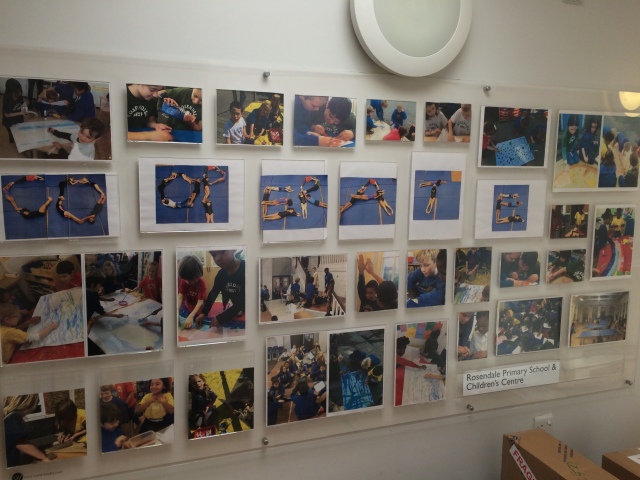In the summer of 2014, the staff, children and governors of Rosendale Primary School worked together to find 5 words that they thought described Rosendale. These 5 words have become the foundations of our school values. Why is it important to have shared values in school? Well, as humans, we base a lot of our decisions and actions on our values, they tell us what is important in our lives. Successful communities across the globe have shared values, a common vocabulary, mutual trust and established rituals.
WELCOME was chosen because the children wanted to show that Rosendale is known for making sure that everyone in its community feels included. We WELCOME everyone with a smile every morning.
Other words we considered were JOY, POSITIVITY and VALUED.
“Welcome” is a mark making project created entirely by the children in Reception. We laid out large pieces of paper outside, and the children brushed, dotted, combed, printed, dripped and generally had fun with the paint. The photos of people holding up “hello” signs represent some of the 58 languages spoken at Rosendale.
COOPERATE was chosen to represent Rosendale’s commitment to mixed ability cooperative learning. The staff also felt that it was important to recognise that much of Rosendale’s success comes from working together as a team, supporting and learning from each other.
Other words we considered were TEAM, COLLABORATE, VALUED
“Cooperate” was made by the Gymnastics Club, forming the word by linking their bodies, and bending into letter shapes. The photos around the word represent how pupils work together in couples and as teams, leaning to negotiate, compromise and encourage each other.

CHALLENGE was chosen to show that at Rosendale we expect everyone – children, staff and parents to strive to be the best they can be. The governors also wanted to represent the huge number of opportunities that we provide for children to explore the wider curriculum, try something new and learn about themselves.
Other words we considered were COURAGEOUS, BUSY, CURIOUS and PRODUCTIVE
“Challenge” has been made from recycled polystyrene, sculpted into icebergs using a hot wire. The letters are being negotiated by Rosendale children, crafted by 6AF from wire and wool. See if you can spot Miss Atkins!
UNDERSTAND was chosen because children, staff and governors wanted to show how important Rosendale’s community is to the identity and ethos of the school. We wanted to appreciate the diverse local community in which the school sits, as well as recognising what it is like to be part of a thriving, busy capital city and to make sure that we give the children all the skills they will need to be part of a developing global community.
Other words we considered were RESPECT, VARIETY, DIVERSE and ORIGINAL
“Understand” is a paper making project made by year 5. We dipped a frame into paper pulp, drained and dried the sheets while embedding objects and images into the pulp, that represent some of the key subjects studied at Rosendale.
EXCITE was chosen because the children wanted to show how great it was to be a pupil at Rosendale. The staff too wanted to recognise how much they enjoy working here. Rosendale is a school that wants to give everyone opportunities.
Other words we considered were VIBRANT, ENERGETIC, CREATIVE, and EXPLORE
“Excite” is made from laser cut acrylic letters, with a background of spin paintings made by various pupils across all ages in the school. Many thanks to Michael Ruh Studios for the loan of their hand made spinning machine.








